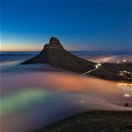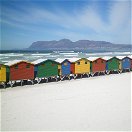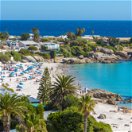The Area
Cape Town's Many Names
Cape Town and the Cape Peninsula are known by a variety of names. Some of these are:
- The Mother City A term used to describe Cape Town, which is South Africa’s oldest city.
- The Cape of Storms
- The name Bartholomew Diaz used in 1486 after he and his three ships battled the storms for 13 days.
- The Cape of Good Hope
- A term used by King John II of Portugal and Bartholomew Diaz, from the great hope it gives of discovering the Indies.
- Tavern of the Seas
- Cape Town has been a stopover port for passing ships for centuries, and has provided a haven and friendly hospitality for the weary traveler.
- The Fairest Cape
- Sir Francis Drake, on his round the world voyage I the 16th century, recorded in his log after seeing the Cape: “A most stately thing, and the fairest Cape we saw in the whole circumference of the earth…” Carl Linnaeus,
- In a letter to Governor Ryk Tulbagh, wrote: “that paradise on earth, the Cape of Good Hope, which The Beneficent Creator has enriched with His choicest wonders…”
Cape Town's Climate - Information for Tourists
The Peninsula’s Mediterranean climate is one of the most pleasant found throughout the world. Its long summer has its peak during December and February with temperatures averaging at around 28 degrees C. The prevailing wind during summer and autumn is from SSE to SSW, mainly from October to march, and is generally known as “The Southeaster”, or the “Cape Doctor”. It brings very little rain with it, but as it travels over the mountain-tops, its low moisture content condenses into clouds which disappear as the air descends, and Table Mountain gets covered by a “tablecloth’ of cloud. (An interesting myth surrounds the Table Mountain “tablecloth”. It is said that Van Hunks, a retired pirate, who smoked an evil- smelling pipe, challenged a stranger (the “Devil”) to a smoking competition on the Devil’s Peak mountainside. The two competitors puffed and puffed until the mountain was covered in a dense cloud - the origin of the tablecloth – and van Hunks was never seen again. He is still puffing away at the “Devil”. Occasionally during summer the Cape will experience northerly “berg winds” which bring with it oppressive heat from the country’s interior. The Southeaster subsides slightly during February and March and these are probably the best months of the summer season.
The prevailing wind during winter and spring blows from N to NW, mainly between May and August, and is called the Northwester. The wind is not as strong as the Southeaster and occurs less frequently. It precedes a cold front and is therefore followed by much needed rain. The rainy season peaks during June and July, but of late the rainy days have reduced in number and Cape Town winters often produce perfect summery days, as a result, winter in Cape Town has become known as the “secret season”.
Beaches and Bays
The Cape Peninsula’s coastline is surrounded by the warm Indian Ocean in the south coast side and the cold Atlantic Ocean on the west coast side. The point where the warm Agulhas Current and the cold Benguela Current meet is not a fixed one and shifts depending on various factors such as the seas on, winds, tides, or water depth. It is cartographically fixed at 20 degrees east.
False Bay Coast
The beaches have warmer water as a result of the Aghulas Current, but are often exposed to the strong South Easter. This coast includes the following beaches, bays and pools: Buffels Bay, Miller’s Point, Boulders Beach, Sea forth Beach, Simon’s Town Harbour, Glencairn Beach, Fish Hoek Beach, Kalk bay Harbour, St James Beach and Pool, Muizenberg Beach, Strandfontein Beach, Mnandi beach, Swartklip, Macassar Beach, the Strand, Gordon’s Bay and Koegelbaai.
Atlantic Coast
The beaches on this side of the coast have ice-cold water supplied by the Benguela Current, but the sand is soft and comfortable and the sunsets are breathtaking. The beaches and bays on this side of the coast are as follows: Mouille Point, Three anchor bay, Sea Point Pavilion, Sunset beach, Queens Beach, Saunders Rock, Clifton bay(which comprises Moses Beach, First beach, Second beach, Third Beach and Fourth Beach, Bachelor’s Cove, Maiden’s Cove, Glen Beach, camps bay, Oudekraal, Llandudno, Sunset Rock, Sandy Bay, Hout Bay, Noordhoek, Longbeach, Kommetjie, Soetwater, Witsands, Misty Bay and Scarborough.









Share This Page